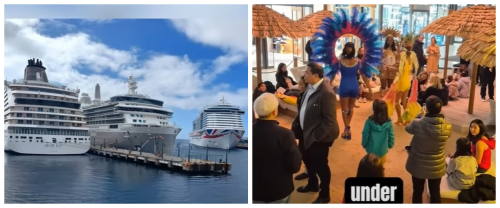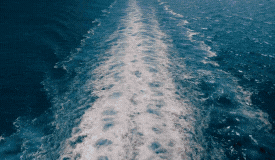 PHILIPSBURG:--- Another Caribbean neighbor has lapped St. Maarten, and we are left wondering if our government was even aware the race had started. St. Kitts recently announced a landmark deal with P&O Cruises, a subsidiary of Carnival Corporation, to establish homeporting operations. This strategic move will transform their island from a simple stopover to a full embarkation and disembarkation hub, injecting significant revenue into multiple sectors of their economy.
PHILIPSBURG:--- Another Caribbean neighbor has lapped St. Maarten, and we are left wondering if our government was even aware the race had started. St. Kitts recently announced a landmark deal with P&O Cruises, a subsidiary of Carnival Corporation, to establish homeporting operations. This strategic move will transform their island from a simple stopover to a full embarkation and disembarkation hub, injecting significant revenue into multiple sectors of their economy.
Meanwhile, in St. Maarten, we have the Princess Juliana International Airport (PJIAE), widely regarded as one of the most distinguished and capable airports in the entire Caribbean. It’s an infrastructural jewel that should be the engine of our economic prosperity. Yet it sits underutilized, a testament to our leadership's staggering lack of vision and execution. While PJIAE boasts about exceeding passenger traffic targets, what does that matter if we fail to capitalize on our most significant assets?
The success in St. Kitts is not accidental. It is the result of a deliberate "Fly Cruise" model where passengers arrive by air, stay in local hotels, dine at restaurants, and shop in stores before their cruise even begins. This is a comprehensive economic strategy that creates a ripple effect of benefits. St. Kitts is investing in a new international cruise terminal at Port Zante to support this growth. What is St. Maarten investing in?
For decades, St. Maarten has been a major player in tourism. This experience should have given us a competitive edge. Instead, we have been overtaken by smaller islands with bigger ambitions. The question is unavoidable: why has St. Maarten, with its superior airport and long history in tourism, failed to secure a single homeporting agreement?
The answer seems to lie in a familiar and frustrating pattern of government mismanagement. While our leaders are quick to travel the globe on promotional tours, the tangible results of these expensive trips remain invisible. Where is the return on investment for the taxpayer? The failure
to secure homeporting is not just a missed opportunity; it is a direct consequence of a government that appears more interested in appearances than in delivering concrete economic wins for its people.
Now, to compound this chronic lack of vision, the government has plunged the country into outright financial paralysis. According to recent reporting from SMN News, St. Maarten is on the brink of a half-year freeze due to catastrophic delays in both the 2026 budget and the crucial 2025 budget amendment. New infrastructure projects, critical payouts for justice workers, and subsidies for those in need have all been ground to a halt. No new hires. No new contracts. No relief for the most vulnerable. The government is reduced to the “1/12th rule,” unable to legally spend on anything except ongoing commitments—and even promised perks and bonuses to civil servants are off the table.
This debacle goes beyond mere incompetence; it borders on constitutional violation. Payments for events like Carnival were reportedly made illegally, before any budget approval, raising the alarming question: what other taxpayer money has been spent without parliamentary consent?
Unchecked, such actions not only risk negative audit opinions and damage to Sint Maarten’s already fragile credit rating but may personally endanger ministers who authorized them.
Even more alarming, the government cannot touch any new revenue until a proper budget is passed. Taxes collected and international transfers meant for urgent development or social relief simply sit, frozen and unusable. Promised Trust Fund and Temporary Work Organization (TWO) projects are at risk of expiring without ever beginning, thanks to this bureaucratic standstill.
This breakdown of financial and democratic oversight leaves Parliament in the dark, unable to hold government accountable or responsibly plan for the public good. Instead of being proactive and visionary, government is perpetually stuck in reactive mode, scrambling to put out fires of its own making.
All of this only deepens the island’s dependence on Dutch aid every time disaster strikes. What could have been an era of growth—driven by strategic investments, homeporting deals, and self-powered economic resilience—is lost to a combination of administrative gridlock, irresponsibility, and willful neglect.
The people of St. Maarten deserve more than excuses and empty promises. We demand accountability for these failures and an immediate plan for pulling the country out of this self-imposed financial limbo. We have the infrastructure. We have the experience. Yet unless voters force a change, St. Maarten’s immense potential will stay locked away—wasted by those who were trusted to lead. The time for reform and real leadership is now.
 PHILIPSBURG:--- The Special team of the police force of Sint. Maarten (KPSM) remained vigilant on Christmas Eve, conducting routine controls and preventative searches throughout the island to ensure public safety during the holiday season.
PHILIPSBURG:--- The Special team of the police force of Sint. Maarten (KPSM) remained vigilant on Christmas Eve, conducting routine controls and preventative searches throughout the island to ensure public safety during the holiday season.





 Simpson Bay:--- Princess Juliana International Airport Operating Company N.V. (PJIAE) is proud to announce its collaboration with the RISE Foundation, reinforcing the organization’s ongoing commitment to supporting local youth and strengthening the community it serves.
Simpson Bay:--- Princess Juliana International Airport Operating Company N.V. (PJIAE) is proud to announce its collaboration with the RISE Foundation, reinforcing the organization’s ongoing commitment to supporting local youth and strengthening the community it serves. PHILIPSBURG:--- Another Caribbean neighbor has lapped St. Maarten, and we are left wondering if our government was even aware the race had started. St. Kitts recently announced a landmark deal with P&O Cruises, a subsidiary of Carnival Corporation, to establish homeporting operations. This strategic move will transform their island from a simple stopover to a full embarkation and disembarkation hub, injecting significant revenue into multiple sectors of their economy.
PHILIPSBURG:--- Another Caribbean neighbor has lapped St. Maarten, and we are left wondering if our government was even aware the race had started. St. Kitts recently announced a landmark deal with P&O Cruises, a subsidiary of Carnival Corporation, to establish homeporting operations. This strategic move will transform their island from a simple stopover to a full embarkation and disembarkation hub, injecting significant revenue into multiple sectors of their economy. PHILIPSBURG:--- A long-simmering transport scandal has erupted in St. Maarten, exposing what appears to be decades of deep-rooted corruption, cronyism, and a blatant betrayal of public trust. An explosive combination of leaked documents and fiery parliamentary debates has blown the lid off a system where taxi, bus, and tour licenses were allegedly hoarded by political elites, used as currency for loyalty, and duplicated in a scheme that has left the public transport sector in chaos.
PHILIPSBURG:--- A long-simmering transport scandal has erupted in St. Maarten, exposing what appears to be decades of deep-rooted corruption, cronyism, and a blatant betrayal of public trust. An explosive combination of leaked documents and fiery parliamentary debates has blown the lid off a system where taxi, bus, and tour licenses were allegedly hoarded by political elites, used as currency for loyalty, and duplicated in a scheme that has left the public transport sector in chaos.





